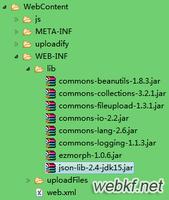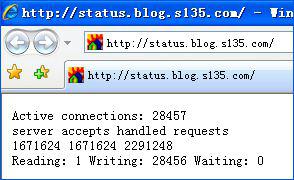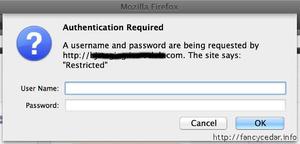Servlet实现多文件上传功能
一、Servlet实现文件上传,需要添加第三方提供的jar包
下载地址:
1) commons-fileupload-1.2.2-bin.zip : 点击打开链接
2) commons-io-2.3-bin.zip : 点击打开链接
接着把这两个jar包放到 lib文件夹下:

二、文件上传的表单提交方式必须是POST方式
编码类型:enctype="multipart/form-data",默认是 application/x-www-form-urlencoded
比如:<form action="FileUpLoad"enctype="multipart/form-data"method="post">
三、举例
1.fileupload.jsp
<%@ page language="java" import="java.util.*" pageEncoding="UTF-8"%>
<%
String path = request.getContextPath();
String basePath = request.getScheme()+"://"+request.getServerName()+":"+request.getServerPort()+path+"/";
%>
<!DOCTYPE HTML PUBLIC "-//W3C//DTD HTML 4.01 Transitional//EN">
<html>
<head>
<base href="<%=basePath%>" rel="external nofollow" rel="external nofollow" >
<title>My JSP 'fileupload.jsp' starting page</title>
<meta http-equiv="pragma" content="no-cache">
<meta http-equiv="cache-control" content="no-cache">
<meta http-equiv="expires" content="0">
<meta http-equiv="keywords" content="keyword1,keyword2,keyword3">
<meta http-equiv="description" content="This is my page">
<!--
<link rel="stylesheet" type="text/css" href="styles.css" rel="external nofollow" rel="external nofollow" >
-->
</head>
<body>
<!-- enctype 默认是 application/x-www-form-urlencoded -->
<form action="FileUpLoad" enctype="multipart/form-data" method="post" >
用户名:<input type="text" name="usename"> <br/>
上传文件:<input type="file" name="file1"><br/>
上传文件: <input type="file" name="file2"><br/>
<input type="submit" value="提交"/>
</form>
</body>
</html>
2.实际处理文件上传的 FileUpLoad.java
package com.servlet.fileupload;
import java.io.File;
import java.io.*;
import java.io.IOException;
import java.io.PrintWriter;
import java.util.List;
import javax.servlet.ServletException;
import javax.servlet.http.HttpServlet;
import javax.servlet.http.HttpServletRequest;
import javax.servlet.http.HttpServletResponse;
import org.apache.commons.fileupload.FileItem;
import org.apache.commons.fileupload.FileUploadException;
import org.apache.commons.fileupload.disk.DiskFileItemFactory;
import org.apache.commons.fileupload.servlet.ServletFileUpload;
/**
*
* @author Administrator
* 文件上传
* 具体步骤:
* 1)获得磁盘文件条目工厂 DiskFileItemFactory 要导包
* 2) 利用 request 获取 真实路径 ,供临时文件存储,和 最终文件存储 ,这两个存储位置可不同,也可相同
* 3)对 DiskFileItemFactory 对象设置一些 属性
* 4)高水平的API文件上传处理 ServletFileUpload upload = new ServletFileUpload(factory);
* 目的是调用 parseRequest(request)方法 获得 FileItem 集合list ,
*
* 5)在 FileItem 对象中 获取信息, 遍历, 判断 表单提交过来的信息 是否是 普通文本信息 另做处理
* 6)
* 第一种. 用第三方 提供的 item.write( new File(path,filename) ); 直接写到磁盘上
* 第二种. 手动处理
*
*/
public class FileUpLoad extends HttpServlet {
public void doPost(HttpServletRequest request, HttpServletResponse response)
throws ServletException, IOException {
request.setCharacterEncoding("utf-8"); //设置编码
//获得磁盘文件条目工厂
DiskFileItemFactory factory = new DiskFileItemFactory();
//获取文件需要上传到的路径
String path = request.getRealPath("/upload");
//如果没以下两行设置的话,上传大的 文件 会占用 很多内存,
//设置暂时存放的 存储室 , 这个存储室,可以和 最终存储文件 的目录不同
/**
* 原理 它是先存到 暂时存储室,然后在真正写到 对应目录的硬盘上,
* 按理来说 当上传一个文件时,其实是上传了两份,第一个是以 .tem 格式的
* 然后再将其真正写到 对应目录的硬盘上
*/
factory.setRepository(new File(path));
//设置 缓存的大小,当上传文件的容量超过该缓存时,直接放到 暂时存储室
factory.setSizeThreshold(1024*1024) ;
//高水平的API文件上传处理
ServletFileUpload upload = new ServletFileUpload(factory);
try {
//可以上传多个文件
List<FileItem> list = (List<FileItem>)upload.parseRequest(request);
for(FileItem item : list)
{
//获取表单的属性名字
String name = item.getFieldName();
//如果获取的 表单信息是普通的 文本 信息
if(item.isFormField())
{
//获取用户具体输入的字符串 ,名字起得挺好,因为表单提交过来的是 字符串类型的
String value = item.getString() ;
request.setAttribute(name, value);
}
//对传入的非 简单的字符串进行处理 ,比如说二进制的 图片,电影这些
else
{
/**
* 以下三步,主要获取 上传文件的名字
*/
//获取路径名
String value = item.getName() ;
//索引到最后一个反斜杠
int start = value.lastIndexOf("\\");
//截取 上传文件的 字符串名字,加1是 去掉反斜杠,
String filename = value.substring(start+1);
request.setAttribute(name, filename);
//真正写到磁盘上
//它抛出的异常 用exception 捕捉
//item.write( new File(path,filename) );//第三方提供的
//手动写的
OutputStream out = new FileOutputStream(new File(path,filename));
InputStream in = item.getInputStream() ;
int length = 0 ;
byte [] buf = new byte[1024] ;
System.out.println("获取上传文件的总共的容量:"+item.getSize());
// in.read(buf) 每次读到的数据存放在 buf 数组中
while( (length = in.read(buf) ) != -1)
{
//在 buf 数组中 取出数据 写到 (输出流)磁盘上
out.write(buf, 0, length);
}
in.close();
out.close();
}
}
} catch (FileUploadException e) {
// TODO Auto-generated catch block
e.printStackTrace();
}
catch (Exception e) {
// TODO Auto-generated catch block
//e.printStackTrace();
}
request.getRequestDispatcher("filedemo.jsp").forward(request, response);
}
}
System.out.println("获取上传文件的总共的容量:"+item.getSize());
3.filedemo.jsp
<%@ page language="java" import="java.util.*" pageEncoding="UTF-8"%>
<%
String path = request.getContextPath();
String basePath = request.getScheme()+"://"+request.getServerName()+":"+request.getServerPort()+path+"/";
%>
<!DOCTYPE HTML PUBLIC "-//W3C//DTD HTML 4.01 Transitional//EN">
<html>
<head>
<base href="<%=basePath%>" rel="external nofollow" rel="external nofollow" >
<title>My JSP 'filedemo.jsp' starting page</title>
<meta http-equiv="pragma" content="no-cache">
<meta http-equiv="cache-control" content="no-cache">
<meta http-equiv="expires" content="0">
<meta http-equiv="keywords" content="keyword1,keyword2,keyword3">
<meta http-equiv="description" content="This is my page">
<!--
<link rel="stylesheet" type="text/css" href="styles.css" rel="external nofollow" rel="external nofollow" >
-->
</head>
<body>
用户名:${requestScope.usename } <br/>
文件:${requestScope.file1 }<br/>
${requestScope.file2 }<br/>
<!-- 把上传的图片显示出来 -->
<img alt="go" src="upload/<%=(String)request.getAttribute("file1")%> " />
</body>
</html>
4.结果页面

下载链接:
1)Struts2之下载 点击打开链接
2)Struts2之上传 点击打开链接
以上是 Servlet实现多文件上传功能 的全部内容, 来源链接: utcz.com/p/213253.html









